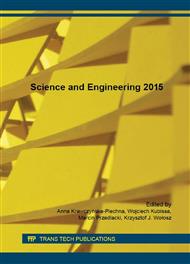p.137
p.145
p.151
p.158
p.166
p.174
p.185
p.192
p.202
Modified Protective Concrete
Abstract:
When designing the concrete constructions their adequate durability must be taken into consideration. This property can be ensured by modifying the composition of the concrete mix. This can be done through the implementation of appropriate admixtures and additives into cement composites. This modification can be called material and structural protection. The addition of silica fume or replacing part of the ordinary aggregate by basalt aggregate can change the protective concrete properties. New generation admixtures also can be used for reducing water/binder ratio. In the study, it decided to examine the effects of additives on the technical properties of the protective concretes. The study consisted of determining the optimal composition and modification of cement composites using silica nanoparticles or basalt aggregate. Different contents of cement were also used. Increase in content of basalt aggregates caused an increase in compressive and flexural strength, respectively, approx. 41% and 66%. In addition, partial replacement of the aggregate resulted in a decrease absorption and water resistance.
Info:
Periodical:
Pages:
166-173
Citation:
Online since:
November 2015
Authors:
Price:
Сopyright:
© 2015 Trans Tech Publications Ltd. All Rights Reserved
Share:
Citation:


